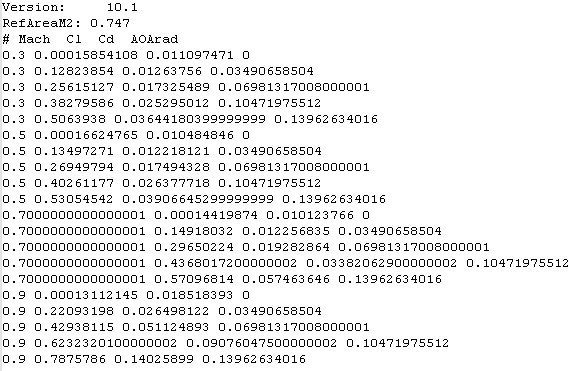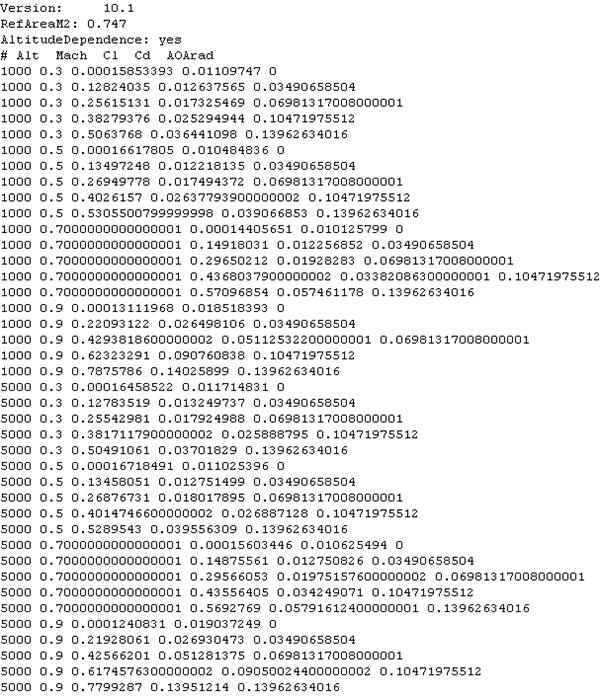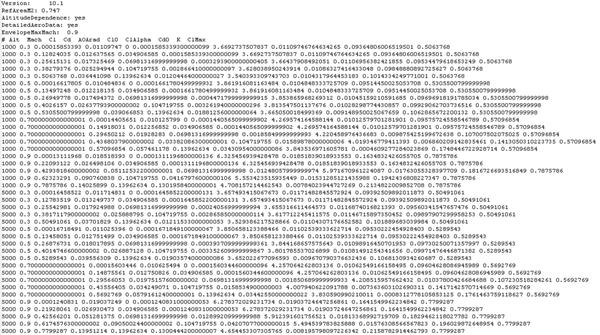This chapter is divided into the following sections:
- 37.2.1. Simple .aero File With Input Parameters Mach and Angle of Attack
- 37.2.2. Simple .aero File With Input Parameters Altitude, Mach and Angle of Attack
- 37.2.3. Advanced .aero File With Input Parameters Mach and Angle of Attack
- 37.2.4. Advanced .aero File With Input Parameters Altitude, Mach and Angle of Attack
This function will export the results of aerodynamic coefficients to a simple format .aero file supported by STK Aviator. This file can be used to define the aerodynamic performance of an aircraft during an AGI STK Aviator simulation.
The format of this file will vary depending on which type of file is selected, and which input parameters are active. Possible combinations are shown below:
Simple .aero file
With input parameters Mach, and Angle of Attack.
With input parameters Altitude, Mach, and Angle of Attack.

Advanced .aero file
With input parameters Mach, and Angle of Attack.
With input parameters Altitude, Mach, and Angle of Attack.

When the command is selected, a panel will appear where the type of file, Simple or Advanced, can be selected. Depending on the selection, a file will be saved to your simulation folder called STK-Aviator-Simple.aero or STK-Aviator-Advanced.aero.
File Format
The following picture shows an example of a Simple .aero file with the following input parameters: Mach and Angle of Attack:

The file header contains the following lines:
Version: 10.1The .aero file version
RefAreaM2: 1The reference area (in square meters) used to compute the aerodynamic coefficients
# Mach Cl Cd AOAradA line header showing the order of variables associated with the values in all subsequent lines
Mach: Mach numberCl: Coefficient of LiftCd: Coefficient of DragAOArad: Angle of Attack (radians)
The remaining contents of the file contain the data associated with each design point. The values are presented in order of increasing mach number, followed by increasing lift coefficient / angle of attack.
Dataset Requirements
In order to correctly export this type of .aero file, the following dataset requirements must be respected.
At least 2
AoA/Clvalues are required for each combination of input Mach.At least 2 input Mach values are required.
Repeated points with shared Mach and AoA are not allowed.
File Format
The following picture shows an example of a Simple .aero file with the following input parameters: Altitude, Mach and Angle of Attack.

The following item is added to the header and contents when compared to the previous Simple .aero file:
Alt: Altitude (m)
Dataset Requirements
In order to correctly export this type of .aero file, the following dataset requirements must be respected.
At least 2
AoA/Clvalues are required for each combination of input Altitude and Mach.At least 3 combinations of input Altitude and Mach values are required.
Repeated points with shared Altitude, Mach and AoA are not allowed.
File Format
The following picture shows an example of an Advanced .aero file with the following input parameters: Mach and Angle of Attack.

The file header contains the following lines:
Version: 10.1The .aero file version.
RefAreaM2: 1The reference area (in square meters) used to compute the aerodynamic coefficients.
DetailedAeroData: yesA variable to specify that this file is an Advanced .aero file.
EnvelopeMaxMach: 0.9The maximum Mach number used in the dataset.
# Cl Mach Cd AOArad Cl0 ClAlpha Cd0 K ClMaxA line header showing the order of variables associated with the values in all subsequent lines.
Cl: Coefficient of LiftMach: Mach numberCd: Coefficient of DragAOArad: Angle of Attack (radians)Cl0: A value that defines the y-position of the Cl vs AOA curve connecting two neighboring design points inside the group of design points that share the same Mach number.ClAlpha: A value that defines the slope of the Cl vs AOA curve connecting two neighboring design points inside the group of design points that share the same Mach number.Cd0: A value that defines the y-position of the Cd vs Cl curve connecting two neighboring design points inside the group of design points that share the same Mach number.K: A value that defines the slope of the Cd vs. Cl curve connecting two neighboring design points inside the group of design points that share the same Mach number.ClMax: The maximum value of the Coefficient of Lift found among each group of design points that share the same input Mach number.
The remaining contents of the file contain the data associated to the design point data. The values are presented in order of increasing Mach number, followed by increasing Coefficient of Lift / Angle of Attack.
In the Advanced
.aero file, the extra variables
(Cl0, ClAlpha,
Cd0, K,
ClMax) are computed from the design point data
using the following two equations. These equations are solved using the neighboring
design points inside each group of design points (design points that share the same
Mach number).
Cl=Cl0+ClAlpha*AOACd=Cd0+K*Cl^2
Dataset Requirements
In order to correctly export this type of .aero file, the following dataset requirements must be respected.
At least 3
AoA/Clvalues are required for each combination of input Mach.At least 2 input Mach values are required.
Repeated points with shared Mach and AoA are not allowed.
File Format
The following picture shows an example of an Advanced .aero file with the following input parameters: Altitude, Mach and Angle of Attack.

The following item is added to the header and contents when compared to the previous Advanced .aero file:
Alt: Altitude (m)
Dataset Requirements
In order to correctly export this type of .aero file, the following dataset requirements must be respected.
At least 3
AoA/Clvalues are required for each combination of input Altitude and Mach.At least 3 combinations of input Altitude and Mach values are required.
Repeated points with shared Altitude, Mach and AoA are not allowed.


